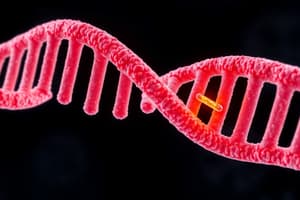Podcast
Questions and Answers
What is primarily responsible for drug absorption in the body?
What is primarily responsible for drug absorption in the body?
- Receptors
- Enzymes
- Proteins (correct)
- Transporters
How can genetic variation influence drug efficacy?
How can genetic variation influence drug efficacy?
- By increasing drug metabolism
- By enhancing drug absorption
- By decreasing drug toxicity
- By altering protein structure (correct)
What is a potential outcome of a genetic mutation in terms of drug response?
What is a potential outcome of a genetic mutation in terms of drug response?
- Decreased metabolism of the drug
- Altered protein function (correct)
- Increased drug concentration in the bloodstream
- Enhanced receptor sensitivity
In pharmacogenetics, what are the two main aspects of drug response being analyzed?
In pharmacogenetics, what are the two main aspects of drug response being analyzed?
Which of the following is an example of a drug target affected by proteins?
Which of the following is an example of a drug target affected by proteins?
What primary function do proteins serve in pharmacokinetics?
What primary function do proteins serve in pharmacokinetics?
What occurs when a protein's structure is altered due to genetic variation?
What occurs when a protein's structure is altered due to genetic variation?
Which term describes the genetic impact on an individual’s response to drugs?
Which term describes the genetic impact on an individual’s response to drugs?
What is one possible negative outcome of altered drug response due to genetic factors?
What is one possible negative outcome of altered drug response due to genetic factors?
What kind of proteins act as drug targets impacting pharmacodynamics?
What kind of proteins act as drug targets impacting pharmacodynamics?
Flashcards
Base Excision Repair
Base Excision Repair
A process where enzymes remove damaged bases from DNA, leaving an apyrimidinic site.
Double-Strand Breaks
Double-Strand Breaks
Double-strand breaks in DNA, caused by radiation or free radicals, are difficult to repair accurately and can lead to serious consequences.
Genomic Variation
Genomic Variation
Genetic variations occur within and between populations, affecting traits like skin color and disease susceptibility.
Single-Nucleotide Polymorphisms (SNPs)
Single-Nucleotide Polymorphisms (SNPs)
Signup and view all the flashcards
Nonsynonymous SNPs
Nonsynonymous SNPs
Signup and view all the flashcards
α-helix
α-helix
Signup and view all the flashcards
Tertiary Structure
Tertiary Structure
Signup and view all the flashcards
Glycosylation
Glycosylation
Signup and view all the flashcards
Genetic Contributions to Drug Response
Genetic Contributions to Drug Response
Signup and view all the flashcards
Pharmacogenetics
Pharmacogenetics
Signup and view all the flashcards
Study Notes
DNA Repair Mechanisms
- Base alterations, such as cytosine deamination, can lead to abnormal bases like uracil.
- Enzymes called glycosylases recognize and remove abnormal bases, creating an apyrimidinic site.
- Double-strand breaks in DNA are induced by radiation or free radicals; traditional repair mechanisms are ineffective for these breaks.
- Repair proteins can re-ligate DNA ends, potentially causing harmful errors, mutations, cancer, or immunodeficiency diseases.
Genomic Variation
- Genetic diversity exists within and between populations, influencing traits like skin color and disease susceptibility.
- Variation arises from mutation, recombination, and natural selection.
- Natural selection favors alleles providing selective advantages.
- Genetic variations can alter phenotypes by affecting gene expression, protein function, or efficacy.
Single-Nucleotide Polymorphisms (SNPs)
- SNPs are single base pair changes, primarily from replication errors.
- More frequent in noncoding regions due to selective pressure on coding domains.
- Synonymous SNPs do not change amino acids, whereas nonsynonymous SNPs can lead to missense (amino acid substitution) or nonsense mutations (premature stop codon).
- Nonsense mutations are more likely to be pathogenic; missense mutation effects depend on amino acid positioning and substitution nature.
- SNPs in noncoding regions may influence gene expression, especially if located in regulatory areas.
Protein Structures
- Secondary structures, such as α-helices and β-sheets, form through intramolecular hydrogen bonding, minimizing steric repulsion.
- Tertiary structure refers to the three-dimensional arrangement of a polypeptide, often revealing structural domains.
Post-Translational Modifications (PTMs)
- Glycosylation involves attaching carbohydrates, significant in eukaryotic proteins, particularly on cell surfaces.
- γ-Carboxylation and β-hydroxylation are PTMs influencing blood coagulation by mediating calcium ion binding.
- Sulfation, the addition of sulfate groups, enhances protein-protein interactions, while amidation, the conversion of a carboxyl group to an amide, stabilizes certain peptides.
Genetic Contributions to Drug Response
- Physicians often prescribe medications based on clinical signs and empirical data, with variability in drug effectiveness (30-60%).
- Only 25% of cancer patients benefit significantly from treatments; many experience adverse effects without improved outcomes.
- Genetic and environmental factors lead to inter-individual variability in drug responses, with genetics explaining 20-95% of pharmacokinetic differences.
- Proteins play vital roles in drug absorption, metabolism, and action; genetic variations can alter protein function, stability, and structure, affecting drug efficacy or toxicity.
Studying That Suits You
Use AI to generate personalized quizzes and flashcards to suit your learning preferences.




